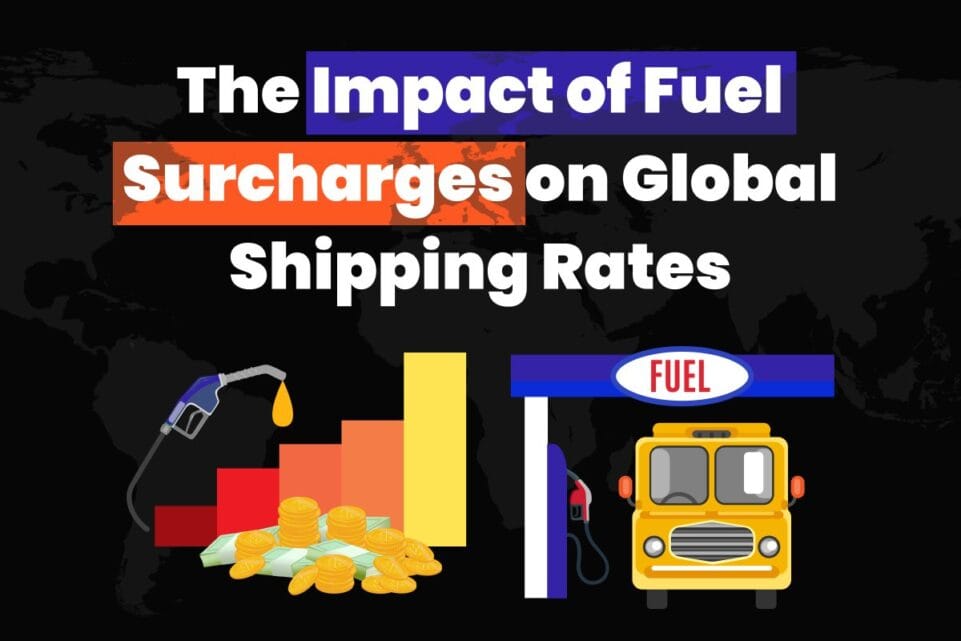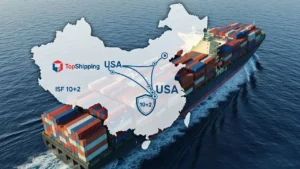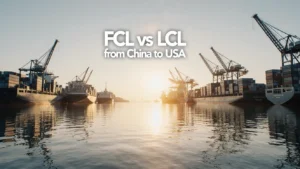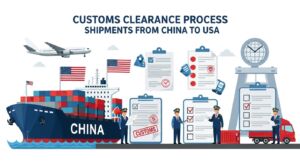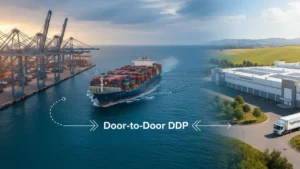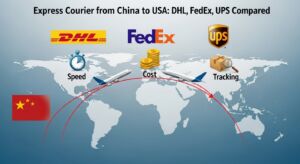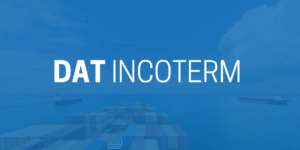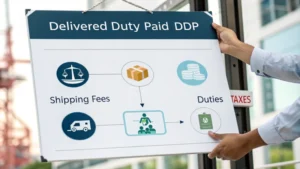Fuel surcharges are now a critical component of global shipping costs, reflecting fluctuations in fuel prices and their cascading effects on freight rates. As international trade continues to grow, logistics companies will increasingly be affected by fuel surcharges in their supply chains. This article will discuss the role of fuel surcharges in international shipping rates and their impact on global trade trends. Lastly, some potential advice for managing costs within the context of your organization’s overall logistics strategy is provided.
Fuel Surcharges and Their Influence on Global Shipping Rates are important for anyone involved in cross-border logistics. It is an important factor influencing international freight rates. As fuel costs continue to rise in shipping, carriers use surcharges to manage operating costs while maintaining their flexibility to adjust pricing. It can create meaningful price differences in the shipping cost breakdown and lead to freight rate fluctuations across modes of transportation. The surcharges that influence freight rate adjustments usually indicate fluctuations in diesel, marine or jet fuel pricing—and thereby have a more direct impact on energy market pricing than logistics operational plans. Thus, the fuel price impact on logistics beyond operational and planning implications, and could alter patterns of global trade and fuel charges.
At Topshipping, we help companies navigate these changes by breaking down energy markets and logistics costs, enabling them to deliver consistent, reliable pricing with complete transparency across all modes.
Introduction to Fuel Surcharges
As an international logistics professional, grasping the definition of fuel surcharge will lead to better management of shipping costs. Fuel surcharges are applied to freight invoices to mitigate increasing shipping fuel costs, which directly influence international freight rates and total logistics costs. These surcharges do not remain constant, as they fluctuate with market fuel prices, which drive and impact freight rate fluctuation and general shipping cost breakdown.
The surcharges serve as a stabilizing mechanism within carrier pricing models and global freight economics, as fuel price trends are factored into freight rate calculations instead of constantly adjusting base rates. These fluctuations also represent the broader fuel price impact on logistics specifically, regarding the by-product impact it has on global trade and fuel charges. Fuel surcharges not only influence energy markets but are also closely related to actual pricing in international shipping.

What is a fuel surcharge?
A fuel surcharge breakdown provides a more detailed explanation of how carriers distinguish between fuel costs and the base shipping rate, and helps clarify shipping surcharge definition for customers. A fuel surcharge breakdown shows how fuel surcharge works by adding a variable charge instead of changing the base rate when fuel prices increase.
A reasonable grasp of what does fuel surcharge mean helps importers and exporters see these charges as an open discussion rather than a hidden cost of service while providing procurement staff with a better framework for accepting logistics pricing.
The fuel surcharges differ between shipments generally formatted as B2B and B2C because there are differences in volume and service levels for shipments involving perishable goods or certain conditions within the global supply chain.
Using one of our continuing growing fuel surcharge templates does not only clarify the conversation; it also gives clients insight into the logic between the two variables, helps improve client understanding of logistics surcharge basics and ultimately provides an avenue for building confidence in our services for freight forwarding, customs brokerage, and distribution services.
Definition and purpose in modern logistics
Definition and purpose in the contemporary logistics world Dynamic pricing is an essential aspect of modern logistics as it allows us to be flexible in a volatile fuel price world resulting in dynamic pricing in shipping. A fuel-related cost adjustment allows carriers to mitigate the impact of rising energy costs without having to negotiate the price of a contract continually. The fuel surcharges are included in the modern shipping charges, allowing freight forwarding services like Topshipping to remain profitable as the fuel and freight markets change.
The fuel surcharge is a standard part of fuel management, allowing companies operating in a global supply chain to operate with certainty when predicting their costs. Like all surcharges, fuel surcharges ensure that organizations have flexible, adaptive, and efficient supply chains, as the carrier can balance the variable costs of freight with their service commitments during periods of change in the fuel market.
Why do shipping companies apply fuel surcharges?
Why do shipping companies use fuel surcharges? The primary reason for fuel surcharge is to protect carriers from unanticipated fuel price swings which can reduce margins. Fuel price fluctuations can cause spikes in diesel and jet fuel prices, so the application of dynamic surcharges can help preserve competitive service levels without compromising financial viability. Carriers view surcharges as part of their operating expenses structure so as not to necessarily absorb all increases in costs. Furthermore, the effects of diesel price changes on freight directly propagate to shippers in a predictable and transparent way.
At Topshipping, a clearly stated fuel surcharge enables us to offer high-quality air and ocean freight forwarding services, even during times of extreme market volatility.
History and evolution of fuel surcharges
The history of fuel surcharges began during the oil crises in the 1970s and 1980s when shipping prices became increasingly volatile. Over time, carriers began adopting pricing models beyond flat rates that included fuel indexes, which indicated the changes to shipping prices based on fuel costs as they changed. This timeline of surcharge use shows that logistics was moving toward adaptable and transparent cost structures for customers.
Modern-day fuel surcharge models have evolved significantly from their origins, which featured fixed extra charges. existing models allow for more frequent adjustments, enabling pricing that closely aligns with the actual cost of fuel.
Today, global logistics providers, including Topshipping, use fuel surcharges to provide responsive and cost-effective international transportation.
How Fuel Surcharges Are Calculated
The fuel surcharge calculation is a technical and simple process. Most are based on a freight surcharge calculation that connects to the actual fuel benchmarks. The carriers use a fuel surcharge formula that typically multiplies the cost by a percentage of more recent fuel averages. These shipment pricing updates are designed to price things fairly and align them to the actual fuel usage. Carriers process this (often based on a logistics surcharge model) quite differently, but being as transparent as possible is the best way to keep trust. At Topshipping we inform our clients how carriers calculate fuel surcharges in order to be as clear as possible and add to our brand equity around accurate international freight rates.
Calculation methods by major carriers
Top logistics companies utilize various strategies. Some apply a percentage-based surcharge, directly linked to increases or decreases in fuel costs. Others use a zone-based surcharge system, where the price is based on distance between origin and destination. Each carrier has specific procedures for determining surcharges. For example, UPS and FedEx adjust their surcharges monthly or weekly based on the fuel index. For Topshipping, a good understanding of these factors and others enables us to compare or benchmark our own surcharge fees against an industry standard. This also enables us to offer clients a clearer explanation on how and why different freight routes may have different fuel surcharges.

Fuel price indices and surcharge matrices
Many carriers already utilise established benchmarks, such as a fuel surcharge index, to establish periodic fees. They produce a shipping fuel table or fuel adjustment matrix to outline and map where fuel prices apply as surcharge percentages. This logistics rate matrix helps clients understand exactly which fuel percentage brackets and how surcharges are applied when fuel prices change. By using index-based pricing, carriers can calculate almost all surcharges based on changing costs as fuel prices increase and decrease, which always helps with predictability. Topshipping can be attributed to its transparency regarding the client’s fuel surcharge matrix, which mirrors the traditional global matrix standard, and clients gain confidence from our market-based pricing.
DOE Index and EIA data references
These industries are valuable resources because they publish credible data on the national diesel price average, thereby serving as another weekly fuel gauge for carriers to determine surcharges. We want to create transparency and neutrality for our customers regarding surcharges, so when Topshipping is in line with these reports, you are aware that our fuel charges are determined by a reliable and objective source, rather than arbitrary assumptions. This measure also helps build our trust within the broader spectrum of our customs brokerage, warehousing, and international shipping efforts.
Update frequency and trigger points
Most fuel surcharge updates will done on a weekly schedule. Different carriers may use a monthly vs weekly surcharge review approach instead. Changes to fuel surcharges happen once a fuel cost price threshold has been crossed. This way, surcharges maintain a good alignment to reflective market prices. Carriers establish change trigger levels for fuel surcharges according to fuel index trends. These trends also indicate when a likely rate adjustment is feasible. If clients know when updates are being made, there is a sense of peace of mind. It helps clients launch their budgets and plan for logistics. At Topshipping, we pay attention to these weekly update cycles; As such, our global shipping rate options are a reflection of real-time fuel charges, with relative same space/period of largely equal operational consistency.
Real examples from UPS, FedEx, and DHL
UPS shares a public UPS fuel surcharge chart that explains the changes in surcharge percentages as jet fuel averages change. FedEx fuel rate are updated monthly helping clients know what to expect in terms of cost changes. DHL surcharge example shows how international freight routes are affected by global fuel trends. The rail and truck examples provided in these surcharge case study examples demonstrate how surcharges shape differences in current fuel surcharge rates for each provider. At Topshipping, we review these industry benchmarks to remain competitive in our surcharge policies, which have been clear to our clients.
Impact on Global Shipping Rates
Fuel surcharges significantly impact freight costs. In international logistics fuel cost volatility is a key driver of costs. Since conditions in global energy markets fluctuate, freight providers adjust the pricing model used to determine the cost of services to either accept cost increases or reductions tied to fuel. This movement is a key driver of global freight rate dynamics and also serves as a significant catalyst for cost changes on many trade lanes. The fuel surcharge effect on freight can harm long-term logistics planning and, thereby, lead to a different total delivered charge that an organization may need to pay, particularly for cross-border organizations. Understanding the impact of fuel surcharges on international shipping can help organizations predict cost changes associated with global shipping rates and more effectively structure international logistics pricing.
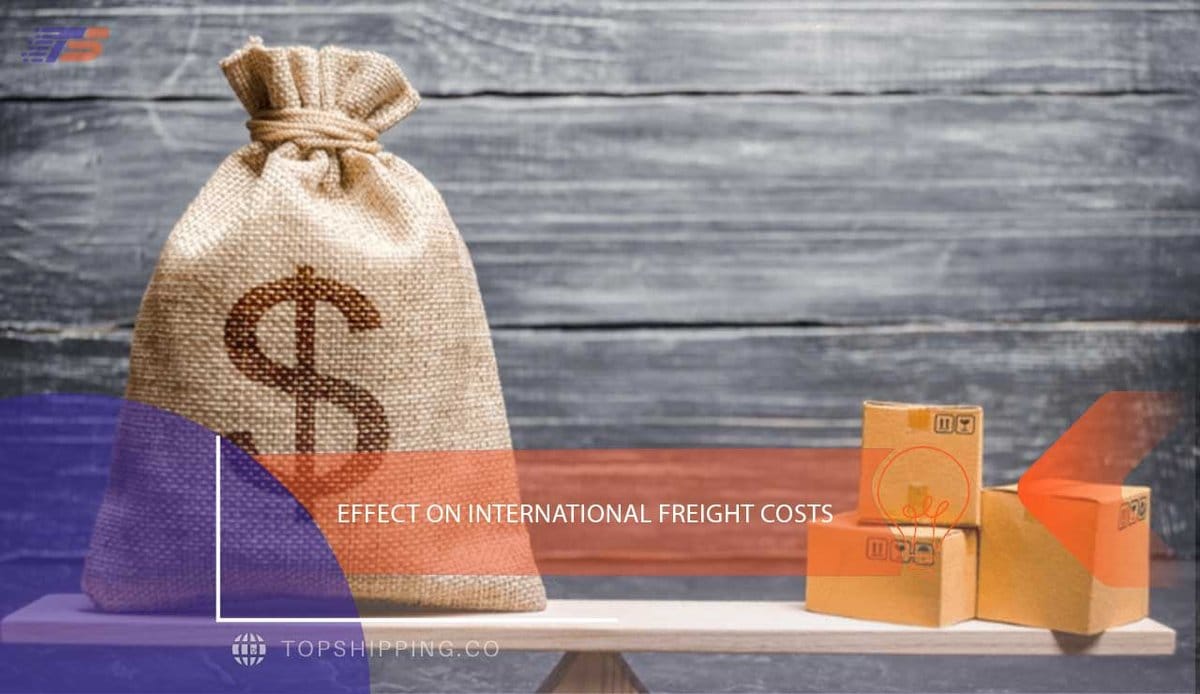
Effect on international freight costs
Fuel surcharges have massive effects on freight as they reflect global shipping rate changes on all transport levels. When energy prices rise, the additional costs are passed on to shippers, who have to increase their international logistics pricing and margins are newer squeezed. By evaluating fuel surcharge effect on freight, companies like Topshipping can better predict how increases in energy prices will affect shipping costs within budgets. The link between energy markets and fuel price impact on shipping costs reinforces the importance of understanding dynamic pricing. Additionally, the trends of global freight rate trends display how decreasing fuel volatility still plays a significant role in determining trade costs within the simplified global price structure present in modern supply chains
Differences by mode: Air, Ocean, Road, Rail
Fuel surcharges vary across different transport options. For example, the air freight surcharge is often the highest because of expensive jet fuel. Conversely, ocean freight includes surcharges such as the BAF (Base Freight) for ocean shipping. Trucking uses road freight diesel costs against a diesel index, while rail is more fuel efficient and less volatile. That being said, this fuel surcharge by transport type drawing illustrates how different modes can be affected by sudden fuel price fluctuations. The most affected modes for surcharges are air and ocean shipments. Rail is the least affected mode because it has some of the most consistent surcharges. The differences in the fuel charge structures need to be understood in order to optimize logistics costs based on the nature of the route, and the chosen mode of transport. At Topshipping, we build mode specific solutions, while balancing cost, speed, and fuel sensitivity for assessing our user and clients to make more informed decisions related to transport.
Jet fuel, BAF, diesel – mode-specific breakdown
Each fuel type has its own unique surcharge model. A jet fuel surcharge applies to air cargo, while container vessels have charged through a bunker adjustment factor (BAF), which reflects changes in marine fuel prices. Road haulers use a diesel fuel index to calculate a trucking fuel rate, and although rail operators also follow diesel benchmarks, they tend to apply surcharges less aggressively. The marine fuel surcharge and index-based surcharges helps to maintain a relationship in terms of reflected fuel dependency among mode types.
Real-world impact: case studies and business data
Investigating a shipping cost case study reveals how surcharges impact certain profit margins more significantly than others, particularly when competing with substantial fluctuations in fuel prices. The real shipping surcharge examples demonstrate how transport bills have grown substantially, prompting many companies to adjust their logistics plans. A typical freight invoice analysis may explain that fuel surcharges often account for 15–30% of all costs carried by shippers; this is significant enough to alter profits. In addition, analyzing the logistics company fuel data often implies that fuel cost exposure varies significantly by industry or shipment volume.
At Topshipping, we collect and share data about our business responses related to fuel surcharges with our clients — to empower them with more information to help make informed decisions and plan for potential long-term cost containment.
Inflation and downstream cost implications
The fuel cost ripple effect is not confined to logistics — in fact, fuel surcharges are a direct contributor to rising consumer prices in the market. When freight costs rise, businesses respond by changing pricing, which often includes a price increase in retail due to logistics. This dynamic connects inflation due to shipping costs to broader supply chain inflation, particularly amongst industries with low profit margins. This creates significant challenges for global shippers, as they must balance freight cost burdens and pricing demands with the market pressures to remain price-competitive. We suggest that clients closely monitor fuel surcharge trends to identify patterns that demonstrate downstream impacts on their business and opportunities for procurement or delivery options.
Industry Entities and Surcharge Policies
Global freight providers, regulatory agencies, and changes in the surcharges practices of carriers influence the landscape of fuel surcharges. When we conduct a fuel surcharge policy comparison, we see that each organization from the carrier to government agencies have different approaches to price modelling. Companies in the freight industry, such as Topshipping, have the responsibility to comply with the applicable policies while balancing charging practices and making it easier for organizations to view the surcharge. The regulatory input from countries and international shipping regulation authorities is crucial in ensuring fair competition and pricing through transparency and disclosure.
Major carriers and their surcharge models
UPS, FedEx and DHL are a few examples of companies that have different models of surcharging for fuel. UPS has a weekly fuel surcharge table that includes a weekly diesel index, while FedEx has two different surcharges for air and ground services, both of which consider the United States’ average fuel price. The DHL shipping fuel surcharge policy also considers service level at the destination country and includes insights into the global surcharge picture. All of these examples of a carrier rate model show the differences in how different carriers approach their fuel surcharges, which can have an impact on global shipping pricing for the shipper. Topshipping continuously reviews and updates our own policy documents and models, to remain competitive and accountable to our stakeholders.
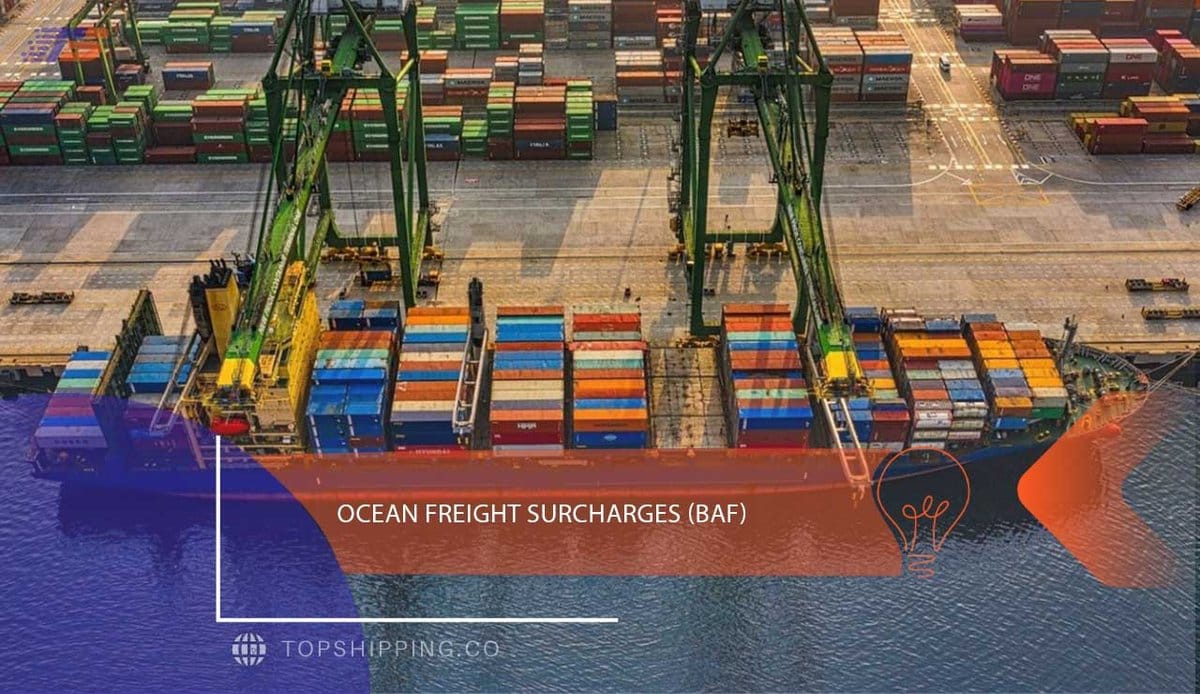
Ocean freight surcharges (BAF)
In sea logistics, the Bunker Adjustment Factor (BAF) is a well-known surcharge in addressing the issue of rising maritime fuel costs. This marine fuel surcharge is applied to both container carriers and bulk carriers; it is established as a percentage of the base freight cost or on a per TEU/ FEU shipped basis. There are different ocean freight surcharge rates, which vary depending on the specific weekly ocean trade lane, as these are subject to fuel volatility and local regulations. The container shipping surcharge is typically reviewed every month, and it is typically linked through bunker indices. At Topshipping we apply our BAF calculations in line with global standards to maintain fairness and trust throughout all ocean freight routes.
Government bodies and regulations
Shipping regulatory bodies such as the U.S. Department of Transportation (DOT) and the Federal Maritime Commission (FMC), as well as their European Union counterparts, oversee charge policies to ensure that shippers are treated fairly and in compliance with regulations. Government agencies further regulate fuel surcharge compliance and how shippers are treated, preventing them from being burdened with hidden charges. The logistics industry regulates the application of fatigue fees, ensuring that consumers understand the actual cost of the logistics operation. Government freight oversight handles and regulates the abuse of surcharges while assuring consistency in practices across all carriers and market transactions. At Topshipping, we ensure that our surcharge practices comply with all applicable legislative schemes to maintain our integrity with customers.
U.S. EIA, FMC, IATA policy influence
Agencies like the U.S. Energy Information Administration (EIA), Federal Maritime Commission (FMC), and the International Air Transport Association (IATA) provide guidance for carrier surcharges by using secure fuel index data sources. Fuel index data surrounds the whole marketplace and creates uniform updates per region based on soft data such as the national diesel price average. As long as you are using indexed measures, there is regulatory consistency for applicable international freight compliance across these larger trading markets. At Topshipping, we reference all indices as we continue to evolve data-driven surcharge models to provide support for industry best practices that increase transparency and drive competition.
Regional differences in surcharge application
Fuel surcharges by region reflect regional fuel markets and unique regulatory environments. Just referencing the comparison of EU vs. US shipping policy, which demonstrates the impact of policies on environmental issues down to a surcharged price, as the fuel cost structure is not transparent or strictly ‘pass-through.’ In the Asia-Pacific freight pricing discussion, we often forget that average regional fuel price increases can develop from rapid market growth and higher volume of shipping routes considered as corridors. Regional differences in fuel price variation also contribute to the surcharge disparity in logistics seen throughout all global lanes. Topshipping is ready to navigate these regional idiosyncrasies by creating pricing models at the trade route level, ensuring clients receive competitive prices that vary regionally.
Business Implications of Fuel Surcharges
Fuel surcharges can drastically impact a company’s business shipping cost structure – particularly if logistics are at the centre of its operations. Aggregate logistics cost impact to business will differ based on the goods being moved, industry, scale of operations, and location, but no one is safe. A surging fuel surcharge creates unpredictability in company budgeting, and increased freight surcharge burden, especially in tumultuous global fuel markets. Both B2B companies and online sellers should be educated on the various levels of shipping cost and cost control methods. Topshipping helps customers manage costs by optimizing routes through the implementation of the lowest-cost practices for air cargo and ocean freight forwarding. Whether it’s B2B freight expense assessment or e-commerce shipping overhead, our solutions are designed to assist in reducing volatility and maintaining margin.
Impact on B2B and e-commerce operations
For wholesalers and exporters, the unpredictability of the B2B logistics pricing model can become even more complicated as surcharges continue to rise. Just as shipping costs for online retailers impact margins negatively for all, a rise in freight surcharges for marketplaces can be inconvenient due to their unmanageable nature—all the marketer can do is examine its options operationally and mitigate their financial exposure. These commercial shipping surcharge impacts increase pressure on delivery timelines, free shipping offers, and distribution of inventory.
Challenges for small and mid-size businesses (SMBs)
The impact of freight cost pressures on small and medium businesses is often much more severe than on larger companies. Inevitably, smaller spills and tighter margins compound issues when surcharges on fuel spike, impacting the outcome of a logistics cost vs. revenue for small business equation. Then there is the complication of whether or not to adopt best practices when adapting to fuel surcharges in SME supply chains and how organizations with less negotiating power could achieve the same advantageous pricing as larger businesses that enjoy the benefits that come from volume leverage. So deep down in your soul, you know that if you are a small or medium business shipping challenges, your business growth and competitiveness are further impacted in an already significantly disrupted global marketplace.
Hence, what solutions does Topshipping provide? We provide small and medium-sized businesses with customized and tailored solutions to manage the rising costs of air and ocean transportation, as well as to help small companies regain control of their shipping logistics by supporting scalable solutions that enable them to own the entire shipping process.

Negotiation strategies and contract design
In order to reduce risks, organizations can include fuel surcharge clauses in their long-term freight contracts the organizations signed with carriers. In the end, the actual agreements signed can always vary with the possible inclusion of surcharge caps in carrier agreements or the use of flexible freight contracts ensuring ready renegotiation if surcharges exceed a certain threshold. Understanding how to negotiate logistics terms is essential in terms of cost outcome predictability. At Topshipping, we help our clients determine an appropriate shipping contract status that provides the leverage and flexibility to mitigate the impact of surcharges on small package and ocean shipments.
Strategies to Mitigate Fuel Surcharge Costs
Reducing shipping fuel surcharges begins with innovative logistics design to determine the best routing, mode and carrier options to deploy. Companies that optimize freight costs through tech-driven, analytical planning, better partner selection, and practices that consume less fuel will be in a better position when surcharges are assessed. We at Topshipping are experts in using logistics efficiency methods to manage surcharge impacts to maintain levels of service and minimize overhead costs. Utilizing analytics and optimized routes, we can support our clients, even faced with rising fuel surcharges, where tight freight expense control is critical in managing fuel costs in uncertain times.
Route and shipment optimization
Freight route planning is absolutely central to the overall exposure of surcharges. The optimal design of delivery networks and utilization of load consolidation minimizes the number of long-haul, fuel-hungry trips. Topshipping helps clients to reduce fuel costs per shipment through AI route optimization. Reducing expenses is important, but speeding delivery and increasing service levels is a more attractive goal. Our systems enable businesses to plan optimized routes that minimize fuel requirements while retaining logistical flexibility.
Working with 3PL providers
Partnering with third-party companies provides logistics savings that smaller shippers typically couldn’t achieve on their own. By utilizing economies of scale and advanced negotiation skills, 3PLs reduce the complexities involved in 3PL fuel surcharge management. Moreover, logistics outsourcing allows smaller shippers or businesses access to expanded networks and visibility as well as a growing understanding of real-time fuel data. There are many businesses that benefit from using freight brokers to help broker more favorable fuel rate terms, flexible service combinations, or better prices. As a trusted 3PL, Topshipping works diligently to provide our clients with fair and optimized freight rates.
Investing in fuel-efficient technologies
Implementing green logistics tech like electric vehicles and automation systems is a viable contributor to fuel use and emission reduction. Hybrid trucks, route optimization, warehouse upgrades are all practical components of sustainable shipping solutions that hedge against surcharge escalations. Investing in energy-saving logistics innovations and operational practices pays long-term dividends, from managing total cost of ownership to enhanced environmental performance. Topshipping encourages businesses to invest in their fuel-efficient operations. This investment is essential for businesses to build resilience in their supply chains while enhancing future readiness.
Electric fleets, telematics, and AI-powered planning
The world of logistics is shifting away from diesel vehicles, and modern last-mile fleets are increasingly employing electric delivery trucks as a diesel-free option. Also, tools like fuel monitoring systems and smart fleet management offer real-time monitoring of fleet performance and alert fleet managers to inefficiencies, which can all be enhanced with AI logistics optimization for more cost savings and automated strategies. Topshipping is introducing these technologies into our services to help clients minimize shipping costs by preparing for the emission-free future of logistics.
Exploring alternative carriers and models
Some companies minimize their exposure to surcharge prices by using models incorporating multi-carrier strategy and eliminating surcharges when using fuel-free delivery options like the bike courier model for last-mile segments. Schools and organizations are transitioning to delivery options that utilize postal services without surcharge, while also negotiating capped rates with carriers. These examples demonstrate the use of relationships and flexible shipping partnerships to allow businesses to pivot from provider to provider based on efficiency with costs or trends seen with rising fuel costs and costs associated with a surcharge. Topshipping provides value to our clients by identifying and managing these alternatives, helping to eliminate unnecessary costs and ensure consistent and predictable logistics performance.
Sustainability and the Future of Fuel Surcharges
As the shipping industry moves toward greener models, sustainable shipping practices are affecting freight pricing models. Companies are utilizing eco-friendly logistics solutions and trying to improve fuel efficiency and emissions. This green shift is boosting a green transformation in supply chains and will likely alter the future of freight pricing. Topshipping is leading the way on this front with sustainable logistics that decrease emissions and long-term cost exposure.
Green logistics and decarbonization
Carbon-neutral shipping and zero-emission freight has become a pretentious component of logistics plans. Global businesses are transitioning to Low-carbon supply chains By implementing effective logistics decarbonization strategies, especially in the realm of international trade. This combination will help reduce surcharges and meet regulatory objectives through investments in green fleet technology. Topshipping is dedicated to helping clients ease the shift towards greener shipping in efforts to manage costs along the way and meet emerging ESG requirements.
Potential rise of carbon surcharges
As climate policy advances, fuel surcharges may evolve into carbon tax in shipping or eco-tariffs in logistics. Some carriers have already implemented sustainability surcharges based on carbon emissions and governments are exploring emissions-based freight fees. There are a number of these climate surcharge models being considered as ways of attempting to price in environmental damage to logistics. Topshipping is closely monitoring each development to assist our clients in remaining compliant and maintaining competitiveness in an evolving, sustainability-focused market.
Are green fees the next fuel surcharge?
There’s a growing case for the viability of green surcharge models, with companies looking to account for climate costs. This includes the use of carbon offset fees, eco-levy in international trade and other future surcharges in shipping models. All these models encourage carriers and shippers to adopt greener technologies in order to avoid higher costs. At Topshipping, we are equipping our clients to face this transition with sustainable logistics planning and transparency.
Forecasting global fuel market trends
There is still uncertainty around future oil price predictions but logistics providers will need to brace themselves for volatility and regulations. It appears that the diesel cost outlook and energy market forecast indicate that rates will likely fluctuate in the short term, while the transition to renewables progresses slowly. Future fuel price volatility and the need for agile pricing models will prevail. In the meantime, developments in the crude oil shipping impact could alter traditional shipping routes. Topshipping will continually assess these dynamics to help our clients anticipate costs and select their shipping options.
Your Fuel Surcharge Questions, Answered
Are fuel surcharges regulated by law?
Yes, carriers will reduce the surcharge components when fuel drops below certain fuel price thresholds by each of their surcharge adjustment policies. Note that decreases may not occur immediately after the market moves, but rather depend on each carrier’s review cycle. Therefore, while there might be a lower fuel surcharge, understanding the timing for when do carriers reduce surcharges is important for preparation and planning. At Topshipping, our policies are transparent to our clients, enabling us to address our goal of shipping cost reduction and avoid surprises when fuel prices fluctuate.
Can shippers avoid fuel surcharges?
While shippers shouldn’t expect to completely avoid fuel surcharges, there are alternative strategies to mitigate them. Some customers will completely avoid surcharges by selecting shipping services without surcharges (e.g., flat-rate services or negotiating exemptions from surcharges in a contracted form). Planning wisely, and avoiding other miscellaneous logistics costs with a multi-carrier solution can also help mitigate the surcharges. At Topshipping, we help our customers navigate these alternatives to gain control over freight pricing.
Final TakeawayFuel surcharges are a widely used form of freight pricing and factor in logistics considerations. In this freight surcharge overview, we examined what fuel surcharges are, why they comprise freight pricing, how they are developed, and what actions can be taken to mitigate their impact on cost. The logistics surcharge overview also include helpful steps such as route optimization strategies, smart contracting, and consideration of the environmental costs of transportation, all of which contribute to understanding and managing costs effectively. All of the key aspects of fuel costs showcase how businesses assess ways to mitigate costs and adjust their methods cautiously and responsively based on market fluctuations. Energy markets continue to evolve and change, while shipping remains more heavily regulated; as the industry fluctuates, international business must remain proactive. Our shipping advice to international business is to be vigilant, informed, and assisted by logistics experts. Companies that manage international freight will always have to be conscious of green surcharges. A cohesive global logistics cost plan helps protect their margins. Logistics companies, like Topshipping, will continue to be a resource for navigating the complexities of the global shipping economy.
